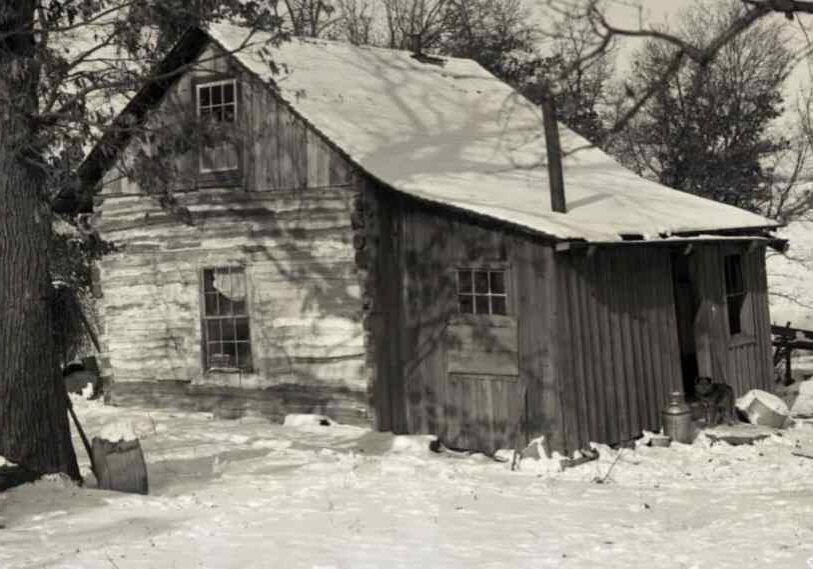Forest Bathing: Meditations on Sound and Movement

CARROLTON TOWNSHIP, FILLMORE COUNTY — I’ve spent hours and hours of my life running alongside, cooking with, drinking, washing with, perspiring, splashing, playing with, soaking in, pouring, and gazing at water, and still I don’t think I’d ever seen it the way that Annie Hejny does.
It took me twenty minutes of speed-walking around the Eagle Bluff Environmental Learning Center’s campus searching for her forest bathing workshop before I realized the event took place Sunday and not Saturday. Laughing at myself, I sat at a picnic table and called my brother, instead, content to sit with my face turned toward the light.
Fortunately, the next day was similarly sunny. And Annie was easy to find – waiting at Eagle Bluff’s entrance to greet those arriving, hair falling in waves over her warm-weather gear, warmth in her tone and demeanor.
A past artist-in-residence at Lanesboro Arts, Hejny’s Forest Bathing Walk in February was part of an artist visit – a week-long series of activities sponsored by a Minnesota State Arts Board grant. An abstract visual artist based in Minneapolis, her artwork is held in private collections both nationally and internationally.
I introduced myself to Hejny, and chatted with members of the Lanesboro-area community who’d driven up to the event. We walked the short span of trail to Eagle Bluff’s North Fire Pit, where we stood in a circle and the approximately dozen of us who’d shown up introduced ourselves to each other.
Annie talked to us about how the next couple hours were to unfold, how forest bathing, although unrelated to actual bathing, is an immersive experience, one where you submerge your senses in the stimuli of your surroundings. She discussed forest bathing’s proven impact on well-being, and how the training she went through to be a guide seemed particularly vital during the covid-times she undertook it in.
Known as shinrin yoku in Japan, forest bathing is a process of relaxation – the practice of being calm amongst nature that can de-stress and deliver health benefits.

Artist Annie Hejny (center) leads a workshop on forest bathing at Eagle Bluff Environmental Learning Center near Lanesboro. (Photo courtesy Lanesboro Arts).
As an Environmental Education Fellow at Eagle Bluff, where the event took place, I am very accustomed to moving quickly through the trails with groups of middle-schoolers who cycle through on a twice-weekly basis. This made me all the more appreciative of this novelty – being there with local adults, being still.
Sound and Movement
We began the workshop, engaging in a variety of what felt to me like different meditations in relationship with the forest in which we stood. We focused on sounds, and I heard trees creak like doors, wind swish and subdue.
We turned our attention to movement, of ourselves and entities in nature, and I sprinted down the path, gave attention to my footfall, watched a leaf meander through the air. After each exercise, we would re-gather and share. I was struck with the poignancy and awe of others’ remarks.
One white-haired woman noted with a twinkle in her eye that she was closer to her life’s end than its start, how walking was a miracle, something to treasure.
We ended with my favorite exercise of the day – yes-and-ing our way through a partner stroll. One partner would say, for example, “Let’s press our cheek into the pine-needles blanketing the ground,” and the other would say, “Yes, let’s!” (My partner and I somersaulted on the trail. I landed crooked on my first one, so I did a second).
But back to the way water ran through my time with Annie that Sunday – she closed out the workshop by pressing into our palms handleless ceramic mugs filled with fresh mint tea, inviting us to pause so we could take our first sips together.
She passed out granola bars. The twinkly-eyed woman wrapped herself in one of the blankets Annie had brought. I was again reminded of the terminology – forest bathing. Of how we never stray very far from the water.
The heart of Hejny’s art is connecting with nature.
After the workshop, Annie and I walked into Eagle Bluff’s dorm building, and both agreed that the sun puddle on the carpet would be a much more desirable location to sit than the shadowed couch and chairs. With her two nose rings matching her hoop earrings, gray and blue hiking boots, green pants, and mint-colored Hydro Flask adorned with a sticker, she could have been another fellow at Eagle Bluff, albeit one with a sense of poised artistic flair about her.

Eagle Bluff’s woods and prairie when the sun and rain meet, reflects the power of nature. (Photo by Ella Deutchman)
We began to talk, Annie’s hands gesticulating in the light as we did. She talked to me about the commissioned artworks she does “with. . .folks who are interested in celebrating and honoring specific bodies of water in their life.” She’ll go down to their shorelines with them, collect water, and use that water in her art.
She explains how she focuses on fresh water, because that’s what she was “born and raised with”, but also due to saltwater’s more tenuous relationship with time. Salinity could, perhaps, reduce archivability – Annie doesn’t know for sure, but guesses it could affect canvas durability, or react with the paint in a corrosive way.
I asked Annie if it tends to be emotional, bringing people down to these bodies of water she is preparing to create art of. She answers without hesitation – generally, yes, for all kinds of reasons. There’s an intimacy in someone inviting you to a space they’ve spent so much time in. People will commission an artwork to mark a milestone – a wedding, a death – something the water can memorialize, or even just hold for a moment. And she’ll bring in her forest bathing techniques: slowing down, invoking gratitude, having people touch and notice the water—in a way that can stir up strong feelings in folks.
Relationship of Art and Water
Annie and I bonded over water metaphors, our voices leaping into exclamation as we nodded at each other’s talk of water’s cyclical nature, the way it moves in us, brackish water and confluences, how water can never be created or destroyed but lives in so many different places and in so many different forms. I felt sheer delight at meeting someone else who grew similarly passionate at the metaphorical implications of geological terms.
As we sat on the dorm lobby floor, the rectangles of light on the rug shifting, Annie told me how engaging with the community through activities such as forest bathing energizes her, how it provides a welcome hiatus and outlet from time spent painting and introspecting alone in a studio.
It is easy to get bogged down, she shares, in the heaviness of the narratives of our time, such as climate change. But watching others practice vulnerability in nature, building community amongst themselves and the world around them, gives her hope.
What struck me the most about Annie, more than her dynamic art bursting with shades of blue, more than the heartening experience of attending her forest bathing workshop, was how pleasant it was to spend time with her. She was easy to be around.

The Mississippi River on a Spring day. The river creates thoughtful vistas from northern Minnesota to the Gulf of Mexico. (Photo by Ella Deutchman)
When I thought more about why, I realized – it is the way in which she wields her attention. It is so easy, when we are all running around to a million places, to lose ourselves in the rush of things. We can become frenetic, absorbing the energy of all that is happening around us, or retreat to a cerebral space, as a kind of escape. It feels easy to become off-kilter.
And something about Annie’s energy felt harmonious to me, simultaneously grounded and full of awe. Maybe it’s all the lessons she’s gleaned from the water, a relationship which she’s refused to take for granted.
With her ankles crossed, elbows hooked around her knees, she talked to me about how she felt a huge responsibility when she realized how vital water was becoming to her artistic voice, how it was this effortful consciousness. How now, she and water are on familiar terms – she sees it everywhere: thanks it during a shower, washes her hands and notices its presence. They have a friendliness, a rapport.
Annie and I ended our conversation with talk of where the Mississippi begins. How water flows abundant in Minnesota: the headwaters up at Lake Itasca; Lake Superior; our land of 11,842 lakes. What would it mean, she wonders aloud, to create works of art based in bodies of water that are drying up? From places deep in drought? How does the work change when the ecosystem changes?
She would love to go to the Gulf, she says. And that journey would be so ripe with a million different meanings – as water travels it gathers, ingesting petrochemicals and plastics, impeded by locks and dams. The river does not flow unencumbered, the river bears the brunt of our excess. We have created a world in which art rooted in water necessarily speaks not simply of the water’s vibrance, but of its suffering, too.
All that is true – and yet, the beauty, where it remains, will not be unacknowledged.

On a rainy day visit to Lake Superior, the lake leaves one in awe of the magnitude of nature. (Photo by Ella Deutchman)
Annie told me how last summer, she did what is called the Lake Superior Circle Tour – a circumnavigation of the lake. She draws a circle through the air with one finger as she tells me this. Her focus was seeing the lake from all sides, and to do so she spent three weeks solo camping, driving herself around the lake’s circumference.
She extends her arms as she talks about Superior, as if words alone cannot contain the feeling, as if water needs a means of communication as multifaceted as itself to work to deliver its meaning.
Later, as I washed my hands, the water felt alive in a way I couldn’t quite put my finger on. I went down to the post-golden-hour Root River to dip in the February stream with my friends, and as we approached, I felt the air change in my bones.
My hope for myself is that each time I submerge my body in a river, every time I sip cool water after a run, whenever I see a lake carrying the purple of the dusk, the words that rise to my lips are thank you.

Root River Current’s coverage of the arts is made possible, in part, by the voters of Minnesota through a grant from the Southeastern Minnesota Arts Council thanks to a legislative appropriation from the arts & cultural heritage fund.






